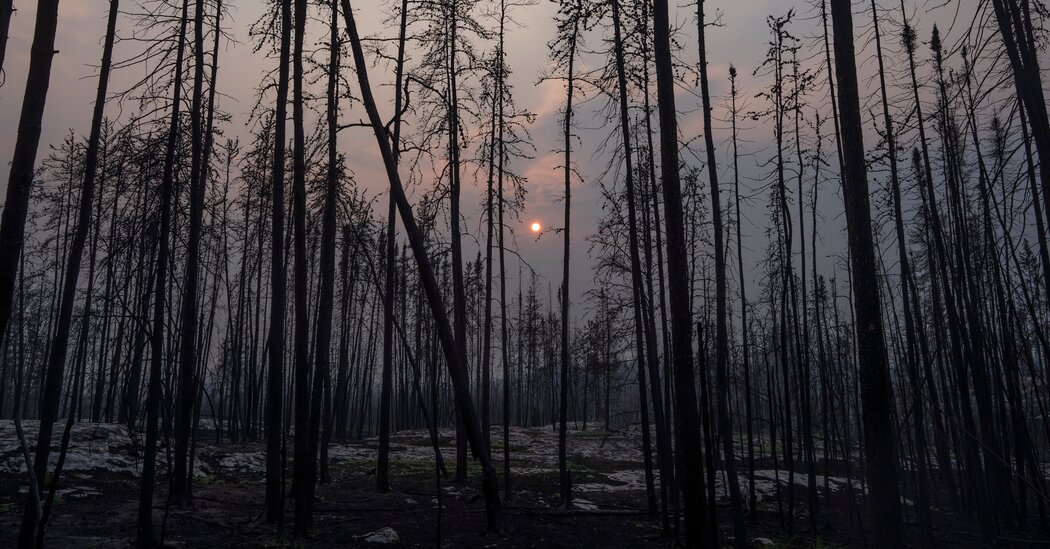The Rising Tide Of Wildfires: Driving Record Global Forest Loss

Table of Contents
The Growing Frequency and Intensity of Wildfires
Climate Change as a Primary Driver
Climate change is undeniably a primary driver of the increasing frequency and intensity of wildfires worldwide. Rising global temperatures, prolonged droughts, and shifting weather patterns create ideal conditions for fire ignition and rapid spread.
- Increased aridity: Higher temperatures lead to drier vegetation, acting as readily available fuel for wildfires.
- Longer fire seasons: Warmer springs and autumns extend the periods when conditions are favorable for wildfires.
- Stronger winds fueling faster fire spread: Changes in atmospheric circulation patterns can result in stronger winds, accelerating fire propagation and making them more difficult to control.
Data from NASA and the IPCC consistently show a strong correlation between rising global temperatures and increased wildfire activity. For example, the average global temperature has risen by approximately 1°C since the pre-industrial era, leading to a significant increase in the number and intensity of wildfires in many regions.
Human Activities Exacerbating the Problem
Human activities significantly exacerbate the wildfire problem. Deforestation, unsustainable land management practices, and human-caused ignitions contribute substantially to the increased risk and severity of wildfires.
- Deforestation: The clearing of forests for agriculture, logging, and urbanization removes natural firebreaks and increases the amount of flammable vegetation. The Amazon rainforest, for instance, has experienced devastating losses due to both deforestation and subsequent wildfires.
- Suppression of smaller fires: A historical policy of aggressively suppressing even small wildfires has, ironically, led to an accumulation of fuel in many forests, resulting in larger, more intense fires when they do occur.
- Human-caused ignitions: Careless disposal of cigarettes, power line malfunctions, and unattended campfires are frequent causes of wildfires, especially in areas with dry vegetation. Invasive species, like certain grasses, often contribute to increased fuel loads and faster fire spread.
Devastating Impacts on Global Forests and Biodiversity
Loss of Forest Cover and Habitat Destruction
Wildfires are causing unprecedented levels of forest loss globally, with devastating consequences for biodiversity. Boreal forests, rainforests, and other ecosystems are particularly vulnerable.
- Statistics on hectares lost annually: Millions of hectares of forest are lost each year to wildfires, with significant variations depending on regional climate conditions and human activities.
- Impact on carbon sequestration: The burning of forests releases massive amounts of carbon dioxide into the atmosphere, exacerbating climate change and creating a vicious cycle.
- Loss of endangered species habitats: Many endangered plant and animal species rely on specific forest habitats that are destroyed or fragmented by wildfires, pushing them closer to extinction. Maps and satellite imagery clearly illustrate the widespread geographical distribution of these losses.
Disruption of Ecosystem Services
Wildfires disrupt essential ecosystem services, impacting water cycles, air quality, and soil health.
- Impact on water resources: Wildfires can alter water flow patterns, leading to increased runoff, erosion, and decreased water quality.
- Increased air pollution: Wildfire smoke contains harmful pollutants that can negatively impact human health and the environment.
- Soil erosion and degradation: The loss of vegetation cover makes the soil vulnerable to erosion, impacting long-term soil fertility and ecosystem recovery. The long-term effects on ecosystem recovery and resilience can take decades, even centuries.
Economic and Social Consequences of Wildfire-Driven Forest Loss
Economic Costs of Wildfires
The economic costs of wildfires are staggering, encompassing firefighting efforts, property damage, and the loss of valuable resources.
- Examples of costly wildfire events: Recent mega-fires have cost billions of dollars in damage and suppression efforts.
- Economic impacts on local communities and industries: Wildfires can devastate local economies, impacting tourism, forestry, and other industries. These economic losses significantly impact regional and national economies.
Social Impacts and Displacement
Wildfires have profound social consequences, including displacement, health problems, and psychological trauma.
- Examples of communities affected by wildfires: Entire communities have been forced to evacuate and relocate due to wildfire devastation.
- Health concerns related to smoke: Exposure to wildfire smoke causes respiratory and cardiovascular problems.
- Mental health impacts: The loss of homes, livelihoods, and community ties can have severe and long-lasting psychological effects on affected populations. Vulnerable populations, such as the elderly and those with pre-existing health conditions, are disproportionately affected.
Mitigation and Adaptation Strategies
Forest Management Practices
Implementing effective forest management practices is crucial in reducing wildfire risk.
- Controlled burns: Prescribed burns help reduce fuel loads and prevent the build-up of flammable materials.
- Forest thinning: Removing excess vegetation creates firebreaks and reduces the intensity of wildfires.
- Improved firebreaks: Strategic placement of firebreaks can help contain the spread of wildfires. Community involvement in forest management is vital for success. Sustainable forestry practices, such as selective logging and reforestation efforts, are critical for long-term wildfire prevention.
Climate Change Mitigation
Addressing climate change is essential for reducing the long-term risk of wildfires.
- Reducing greenhouse gas emissions: Transitioning to renewable energy sources and implementing energy efficiency measures are crucial steps.
- International cooperation and policy initiatives: Global cooperation is necessary to achieve significant reductions in greenhouse gas emissions and adapt to the impacts of climate change.
Conclusion
The escalating threat of wildfires and their devastating consequences for global forests and human societies cannot be overstated. The interconnectedness of wildfires and global forest loss is undeniable, demanding urgent and comprehensive action. We've seen the immense economic losses, the disruption of vital ecosystem services, and the profound social impacts. Understanding this connection is crucial. Take action today to help protect our forests and mitigate the devastating effects of these increasingly frequent and intense wildfires. Support organizations working on wildfire prevention and forest conservation, and advocate for policies that address climate change and improve forest management practices. Let's work together to safeguard our planet's precious forests for future generations.

Featured Posts
-
 Finding Your Dream Country Home For Under 1 Million
May 24, 2025
Finding Your Dream Country Home For Under 1 Million
May 24, 2025 -
 Amsterdam Stock Index Plunges Over 4 Drop To Year Low
May 24, 2025
Amsterdam Stock Index Plunges Over 4 Drop To Year Low
May 24, 2025 -
 Evrovidenie Pobediteli Poslednikh 10 Let I Ikh Sudba Segodnya
May 24, 2025
Evrovidenie Pobediteli Poslednikh 10 Let I Ikh Sudba Segodnya
May 24, 2025 -
 Canadians Cutting Corners On Car Security Due To Inflation
May 24, 2025
Canadians Cutting Corners On Car Security Due To Inflation
May 24, 2025 -
 Trumps Tariff Decision 8 Surge In Euronext Amsterdam Stock Trading
May 24, 2025
Trumps Tariff Decision 8 Surge In Euronext Amsterdam Stock Trading
May 24, 2025
Latest Posts
-
 Memorial Day Weekend 2025 Ocean City Rehoboth And Sandy Point Beach Forecast
May 24, 2025
Memorial Day Weekend 2025 Ocean City Rehoboth And Sandy Point Beach Forecast
May 24, 2025 -
 Official Kermit The Frog Confirmed For Umds 2025 Graduation Ceremony
May 24, 2025
Official Kermit The Frog Confirmed For Umds 2025 Graduation Ceremony
May 24, 2025 -
 Hi Ho Kermit University Of Maryland Names Commencement Speaker For 2025
May 24, 2025
Hi Ho Kermit University Of Maryland Names Commencement Speaker For 2025
May 24, 2025 -
 Famous Amphibian Delivers Inspiring Commencement Address At University Of Maryland
May 24, 2025
Famous Amphibian Delivers Inspiring Commencement Address At University Of Maryland
May 24, 2025 -
 University Of Maryland Graduation Kermit The Frogs Inspiring Speech
May 24, 2025
University Of Maryland Graduation Kermit The Frogs Inspiring Speech
May 24, 2025
